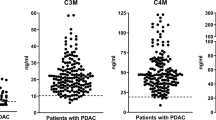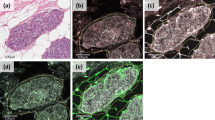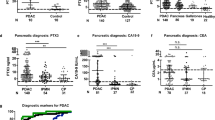Abstract
It is now recognised that epithelial-stromal interactions are important in a wide range of disease processes including neoplasia and inflammation. Metalloproteinases are central to matrix degradation and remodelling, which are key events in tumour invasion and metastasis and may also be involved in tissue changes occurring in chronic inflammation. Immunohistochemistry was performed on sections from 50 patients with pancreatic cancer (n = 27), ampullary cancer (n = 12), low bile duct cancer (n = 3), neuroendocrine tumours (n = 3) and chronic pancreatitis (n = 5), using antibodies raised against collagenase (MMP2), stromelysin (MMP3) and tissue inhibitor of metalloproteinase (TIMP1) and developed using the avidin-biotin complex method. Abundance of MMP2, MMP3 and TIMP1 was greater in pancreatic and ampullary cancer than any other pathology and immunoreactivity in the malignant epithelial cells in pancreatic and ampullary cancer was greater than in the stromal tissues (in pancreatic cancer: MMP2 100% vs 37%, MMP3 93% vs 15%, TIMP1 93% vs 4%, P < 0.0001). There were strong correlations between the immunoreactivity of the two antibodies for MMP2 (P < 0.0001), between MMP2 and TIMP1 (P < 0.0001) and between MMP3 and TIMP1 (P < 0.0001). The immunoreactivity for TIMP1 in pancreatic and ampullary cancers with lymph node metastases was significantly less compared with those cases without lymph node metastases (P < 0.02) and there was an association between increased immunoreactivity for MMP2 and the degree of tumour differentiation (P < 0.01). The results implicate MMP2, MMP3 and TIMP1 in the invasive phenotype of pancreatic and ampullary cancer.
This is a preview of subscription content, access via your institution
Access options
Subscribe to this journal
Receive 24 print issues and online access
$259.00 per year
only $10.79 per issue
Buy this article
- Purchase on Springer Link
- Instant access to full article PDF
Prices may be subject to local taxes which are calculated during checkout
Similar content being viewed by others
Author information
Authors and Affiliations
Rights and permissions
About this article
Cite this article
Bramhall, S., Stamp, G., Dunn, J. et al. Expression of collagenase (MMP2), stromelysin (MMP3) and tissue inhibitor of the metalloproteinases (TIMP1) in pancreatic and ampullary disease. Br J Cancer 73, 972–978 (1996). https://doi.org/10.1038/bjc.1996.190
Issue Date:
DOI: https://doi.org/10.1038/bjc.1996.190
This article is cited by
-
The protective effect of betacellulin against acute pancreatitis is ERBB4 dependent
Journal of Gastroenterology (2020)
-
The hepatic pre-metastatic niche in pancreatic ductal adenocarcinoma
Molecular Cancer (2018)
-
Postoperative Outcomes of Enucleation and Standard Resections in Patients with a Pancreatic Neuroendocrine Tumor
World Journal of Surgery (2016)
-
Urinary TIMP-1 and MMP-2 levels detect the presence of pancreatic malignancies
British Journal of Cancer (2014)
-
Thyroid hormone receptor represses miR-17 expression to enhance tumor metastasis in human hepatoma cells
Oncogene (2013)



